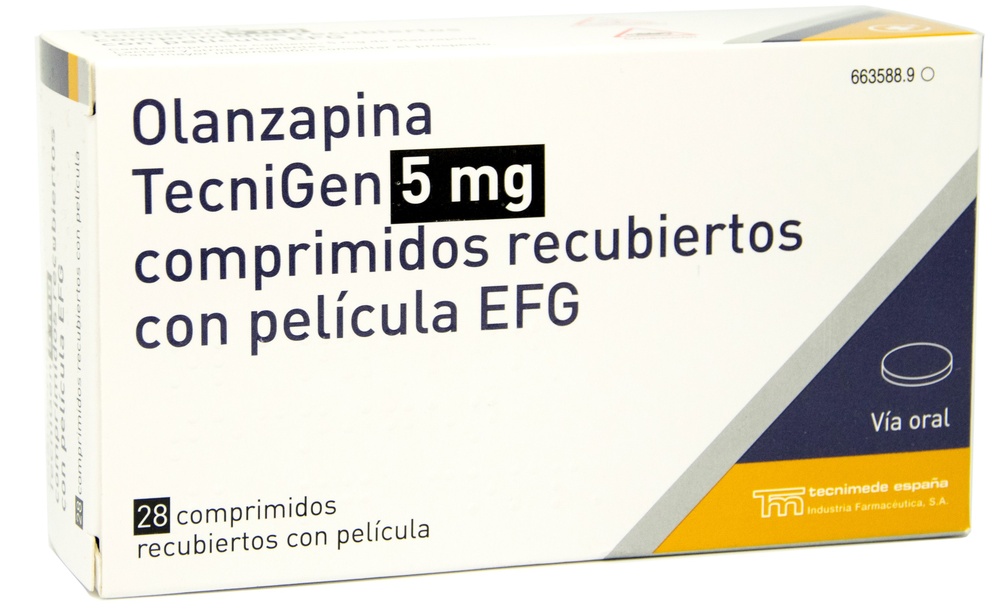

OLANZAPINA TECNIGEN 5 mg COMPRIMIDOS REVESTIDOS POR PELÍCULA

Pergunte a um médico sobre a prescrição de OLANZAPINA TECNIGEN 5 mg COMPRIMIDOS REVESTIDOS POR PELÍCULA

Como usar OLANZAPINA TECNIGEN 5 mg COMPRIMIDOS REVESTIDOS POR PELÍCULA
Introdução
Prospecto: informação para o
Olanzapina TecniGen 5 mg comprimidos revestidos EFG
Leia todo o prospecto detenidamente antes de começar a tomar o medicamento.
- Conserva este prospecto, pois pode ter que voltar a lê-lo.
- Se tiver alguma dúvida, consulte o seu médico ou farmacêutico.
- Este medicamento foi prescrito para si e não deve ser dado a outras pessoas, embora tenham os mesmos sintomas, pois pode prejudicá-las.
- Se considera que algum dos efeitos adversos que sofre é grave ou se apercebe de qualquer efeito adverso não mencionado neste prospecto, informe o seu médico ou farmacêutico.
Conteúdo do prospecto
- O que é Olanzapina TecniGen 5 mg comprimidos revestidos e para que se utiliza
- Antes de tomar TecniGen 5 mg comprimidos revestidos
- Como tomar Olanzapina TecniGen 5 mg comprimidos revestidos
- Posíveis efeitos adversos
- Conservação de Olanzapina TecniGen 5 mg comprimidos revestidos
Informação adicional
1. O que é Olanzapina TecniGen 5 mg comprimidos e para que se utiliza
Olanzapina pertence a um grupo de medicamentos denominados antipsicóticos.
Olanzapina TecniGen é utilizada para tratar
- uma doença com sintomas tais como ouvir, ver ou sentir coisas irreais, crenças erradas, suspeita incomum, e tendência ao retraimento. As pessoas que sofrem desta doença podem encontrar-se, além disso, deprimidas, ansiosas ou tensas.
- um distúrbio caracterizado por sintomas tais como sentir-se eufórico, ter uma energia exagerada, uma necessidade de dormir muito menos do que o habitual, falar muito depressa com fuga de ideias e, às vezes, uma irritabilidade considerável. É também um estabilizador do humor que previne a aparição de variações extremas no estado de ânimo associadas a esta doença.
2. Antes de tomar TecniGen 5 mg comprimidos revestidos
Não tome Olanzapina TecniGen:
- Se é alérgico (hipersensível) a olanzapina ou a qualquer um dos outros componentes de Olanzapina. A reação alérgica pode manifestar-se em forma de erupção, picazón, inchação da face ou dos lábios ou dificuldade para respirar. Se lhe acontecer isto, diga-o ao seu médico.
- Se previamente lhe foi diagnosticado glaucoma de ângulo estreito.
Tenha especial cuidado com Olanzapina TecniGen:
- Medicamentos deste tipo podem provocar movimentos incomuns, sobretudo na face ou na língua. Se lhe acontecer isto após ter tomado Olanzapina, diga-o ao seu médico.
- Muito raramente, medicamentos deste tipo produzem uma combinação de febre, respiração acelerada, suor, rigidez muscular e sonolência. Se lhe acontecer isto, entre em contacto imediatamente com o seu médico.
- Se você ou alguém na sua família tem antecedentes de coágulos sanguíneos, estes medicamentos podem associar-se à formação dos mesmos.
Se você padece alguma das seguintes doenças, diga-o ao seu médico o mais cedo possível:
- Diabetes
- Doença do coração
- Doença do fígado ou rim
- Doença de Parkinson
- Epilepsia
- Problemas de próstata
- Bloqueio intestinal (Íleo paralítico)
- Distúrbios da sangue
- Acidente cerebrovascular ou acidente isquémico transitório
Se você sofre demência, você ou o seu cuidador ou familiar devem informar o seu médico se já teve algum acidente vascular cerebral ou acidente isquémico transitório.
Crianças e adolescentes menores de 18 anos
Os pacientes menores de 18 anos não devem tomar Olanzapina
Idosos
A utilização de Olanzapina em pacientes de idade avançada com demência não é recomendada, pois pode ter efeitos adversos graves.
Como precaução rotineira, se você tem mais de 65 anos, convém que o seu médico o controle a tensão arterial.
Uso de outros medicamentos
Informa ao seu médico ou farmacêutico se está utilizando ou utilizou recentemente outros medicamentos, mesmo os adquiridos sem receita.
Informa ao seu médico especialmente se está tomando medicação para a doença de Parkinson.
Só tome outros medicamentos ao mesmo tempo que Olanzapina, se o seu médico o autorizar. É possível que você sinta certa sensação de sono se combinar olanzapina com antidepressivos ou medicamentos para a ansiedade ou que ajudem a dormir (tranquilizantes).
Deve informar ao seu médico se está tomando fluvoxamina (antidepressivo) ou ciprofloxacino (antibiótico), pois pode ser necessário modificar a sua dose de Olanzapina.
Toma de Olanzapina com os alimentos e bebidas
Olanzapina pode ser tomada com ou sem alimentos.
Não deve beber álcool se lhe foi administrada Olanzapina, pois a combinação de Olanzapina e álcool pode produzir sonolência.
Gravidez e amamentação
Consulte o seu médico ou farmacêutico antes de utilizar qualquer medicamento.
Se você está grávida ou acha que pode estar, consulte o seu médico antes de tomar este medicamento. Não deve tomar este medicamento durante a gravidez, a não ser que se o recomende o seu médico.
Os recém-nascidos de mães que utilizaram Olanzapina TecniGen no último trimestre de gravidez podem apresentar os seguintes sintomas: tremores, rigidez muscular e/ou fraqueza, sonolência, agitação, problemas para respirar e para receber alimentação. Se o seu filho recém-nascido apresentar algum destes sintomas, entre em contacto com o seu médico.
Não deve tomar este medicamento quando estiver a amamentar, pois pequenas quantidades de Olanzapina podem passar para o leite materno.
Condução e uso de máquinas
Existe o risco de sofrer sonolência quando você estiver tomando Olanzapina. Se lhe acontecer isto, não conduza veículos nem use maquinaria. Consulte-o com o seu médico.
Informação importante sobre alguns dos componentes de Olanzapina
Este medicamento contém lactose. Se o seu médico lhe indicou que padece uma intolerância a certos açúcares, consulte com ele antes de tomar este medicamento.
3. Como tomar Olanzapina TecniGen 5 mg comprimidos revestidos
Siga exatamente as instruções de administração de Olanzapina indicadas pelo seu médico. Consulte o seu médico ou farmacêutico se tiver dúvidas.
O seu médico indicar-lhe-á quantos comprimidos de Olanzapina deve tomar e durante quanto tempo. A dose diária de Olanzapina oscila entre 5 e 20 mg. Consulte com o seu médico se voltar a sofrer os sintomas, mas não deixe de tomar Olanzapina a menos que o seu médico o diga.
Deve tomar os seus comprimidos de Olanzapina uma vez ao dia, seguindo as instruções do seu médico. Procure tomar os comprimidos à mesma hora todos os dias. Pode tomar os comprimidos com ou sem alimentos. Os comprimidos de Olanzapina são para administração por via oral.
Deve engolir os comprimidos inteiros com água.
Não interrompa o tratamento quando achar que se encontra melhor. É muito importante que continue a tomar Olanzapina enquanto o seu médico o disser.
Se tomar mais Olanzapina do que devia
Em caso de sobredose ou ingestão acidental, consulte imediatamente o seu médico ou farmacêutico ou ligue para o Serviço de Informação Toxicológica, telefone: 91 562 04 20, indicando o medicamento e a quantidade ingerida. Recomenda-se levar o frasco e o prospecto do medicamento ao profissional de saúde.
Os pacientes que tomaram mais Olanzapina do que deviam experimentaram os seguintes sintomas: batimentos rápidos do coração, agitação/agressividade, problemas com a fala, movimentos incomuns (especialmente da face e da língua) e um nível reduzido de consciência. Outros sintomas podem ser: confusão aguda, convulsões (epilepsia), coma, uma combinação de febre, respiração rápida, suor, rigidez muscular, sonolência ou letargia, enlentecimento da frequência respiratória, aspiração, aumento da pressão arterial ou diminuição da pressão arterial, ritmos anormais do coração. Entre em contacto com o seu médico ou dirija-se imediatamente ao hospital. Mostre ao médico o frasco com os comprimidos.
Se esquecer de tomar Olanzapina
Tome o seu comprimido assim que se lembrar. Não tome uma dose dupla para compensar as doses esquecidas.
Se interromper o tratamento com Olanzapina
Não deixe de tomar Olanzapina a menos que o seu médico o diga.
Se deixar repentinamente de tomar Olanzapina, pode ter sintomas como suor, impossibilidade para dormir, tremores, ansiedade, náuseas ou vómitos. O seu médico pode sugerir-lhe reduzir a dose gradualmente antes de deixar o tratamento.
Se tiver alguma outra dúvida sobre o uso deste produto, pergunte ao seu médico ou farmacêutico.
4. Posíveis efeitos adversos
Como todos os medicamentos, Olanzapina pode produzir efeitos adversos, embora nem todas as pessoas os sofram.
Neste prospecto, quando um efeito adverso é definido como “pouco frequente”, significa que foi notificado em mais de 1 de cada 1.000 pacientes. Quando um efeito adverso é definido como “raro”, significa que foi notificado em mais de 1 de cada 10.000 pacientes, mas em menos de 1 de cada 1.000. Quando um efeito adverso é definido como “muito raro”, isto significa que foi notificado em menos de 1 de cada 10.000 pacientes.
Os efeitos adversos de Olanzapina podem ser sonolência ou cansaço excessivo, aumento de peso, tonturas, aumento do apetite, retenção de líquidos, constipação, secura da boca, agitação, movimentos incomuns (especialmente da face ou da língua), tremores, rigidez muscular ou espasmos, alterações do linguagem e mudanças nos níveis de algumas células sanguíneas e gorduras circulantes. Em alguns pacientes, desenvolveu-se, em muito raras ocasiões, inflamação do pâncreas, causando-lhes forte dor de estômago, febre e malestar.
Como efeitos adversos pouco frequentes, foram notificados o “síndrome de pernas inquietas” e salivação excessiva.
Algumas pessoas experimentam tonturas ou desmaios (com batimentos do coração mais lentos) nas primeiras fases do tratamento, sobretudo ao incorporar-se quando se está deitado ou sentado. Esta sensação costuma desaparecer espontaneamente, mas se não acontecer, comunique-o ao seu médico.
Foram notificados, em muito raras ocasiões, casos de pacientes com ritmos anormais do coração que podem ser graves.
Durante o tratamento com olanzapina, os pacientes de idade avançada com demência podem sofrer acidente vascular cerebral, pneumonia, incontinência urinária, quedas, cansaço extremo, alucinações visuais, uma subida da temperatura corporal, eritema da pele e ter problemas ao caminhar. Foram comunicados alguns óbitos neste grupo particular de pacientes.
Olanzapina pode piorar os sintomas em pacientes com doença de Parkinson.
Em raras ocasiões, Olanzapina pode produzir uma reação alérgica (p. ex., inflamação da boca e da garganta, picazón, erupção), frequência cardíaca lenta ou sensibilidade à luz do sol. Também foram comunicados, em raras ocasiões, doenças do fígado. Em muito raras ocasiões, foram comunicados casos de ereção prolongada e/ou dolorosa ou dificuldade para urinar, descida da temperatura corporal normal, coágulos sanguíneos que se apresentam, p. ex., como trombose venosa profunda das pernas ou distúrbio muscular que se apresenta como dores sem explicação. Alguns pacientes, em muito raras ocasiões, experimentaram níveis altos de açúcar no sangue ou sintomas iniciais de um agravamento da diabetes, com cetoacidose (acetona no sangue e na urina) ou coma.
Os coágulos de sangue nas veias, especialmente nas pernas (os sintomas incluem inchação, dor e eritema na perna), podem deslocar-se através dos vasos sanguíneos até os pulmões, causando dor no peito e dificuldade para respirar. Se observar algum destes sintomas, consulte um médico imediatamente.
Foram comunicados reações alérgicas graves, como o Síndrome de Reação a Fármaco com Eosinofilia e Sintomas Sistémicos (DRESS). DRESS manifesta-se inicialmente com sintomas semelhantes aos da gripe, com erupção cutânea na face que se estende depois a outras zonas, febre, inchação dos gânglios linfáticos, níveis elevados de enzimas hepáticas nos análises de sangue e aumento de um tipo de glóbulos brancos (eosinofilia).
Em raras ocasiões, mulheres que estejam tomando, durante um longo período de tempo, medicamentos deste tipo podem segregar leite pela glândula mamária, deixar de ter mensalmente o período ou tê-lo de forma irregular. Se persistir esta situação, consulte o seu médico.
Muito raramente, os bebês de mães que tomaram Olanzapina no último estágio da gravidez (terceiro trimestre) podem apresentar tremores, sonolência ou letargia.
Podem ocorrer convulsões em raras ocasiões. Na maioria dos casos, existiam antecedentes de convulsões (epilepsia).
Se considera que algum dos efeitos adversos que sofre é grave ou se apercebe de qualquer efeito adverso não mencionado neste prospecto, informe o seu médico ou farmacêutico.
5. Conservação de Olanzapina TecniGen 5 mg comprimidos revestidos
Mantenha fora do alcance e da vista das crianças.
Não utilize este medicamento após a data de validade que aparece no invólucro. A data de validade é o último dia do mês que se indica.
Não conserve a uma temperatura superior a 25°C. Conserve no embalagem original para protegê-lo da luz e da humidade.
Os medicamentos não devem ser jogados fora pelos esgotos nem para o lixo. Deposite os invólucros e os medicamentos que não precisa no Ponto SIGRE da farmácia. Em caso de dúvida, pergunte ao seu farmacêutico como se livrar dos invólucros e dos medicamentos que não precisa. Deste modo, ajudará a proteger o meio ambiente.
6. Informação adicional
Composição de Olanzapina TecniGen 5 mg
O princípio ativo é olanzapina. Cada comprimido contém 5 mg de princípio ativo.
Os outros componentes são: Núcleo: lactose monohidrato, hidroxipropilcelulosa, crospovidona, celulosa microcristalina e estearato de magnésio. Revestimento: Hidroxipropilmetilcelulosa 6cP, dióxido de titânio e polietilenglicol 400.
Aspecto de Olanzapina TecniGen 5 mg e conteúdo do invólucro
Olanzapina TecniGen 5 mg apresenta-se em forma de comprimidos revestidos com película redondos, sem ranhura, com núcleo amarelo e revestimento branco.
Aparece em blister com 28 comprimidos. Pode ser que apenas alguns tamanhos de invólucros estejam comercializados.
Outras apresentações:
Olanzapina TecniGen 10 mg comprimidos EFG, 28 comprimidos
Olanzapina TecniGen 10 mg comprimidos EFG, 56 comprimidos
Titular da autorização de comercialização
Tecnimede España Industria Farmacéutica S.AAvda. de Bruselas, 13, 3º D. Edificio América. Polígono Arroyo de la Vega,
28108 Alcobendas (Madrid) ESPAÑATel: 91 383 51 66Fax: 91 383 51 67E-mail: [email protected]
Responsável pela fabricação
West Pharma - Produções de Especialidades Farmacêuticas, S.A.
Rua João de Deus, nº 11, Venda Nova. 2700 Amadora.
PORTUGAL
Atlantic Pharma – Produções Farmacêuticas SA
Rua da Tapada Grande nº 2, Abrunheira. 2710 – 089 Sintra (Portugal).
Este prospecto foi revisado em janeiro de 2020
A informação detalhada e atualizada deste medicamento está disponível na página Web da Agência Española de Medicamentos e Produtos Sanitários (AEMPS) http://www.aemps.gob.es/

Quanto custa o OLANZAPINA TECNIGEN 5 mg COMPRIMIDOS REVESTIDOS POR PELÍCULA em Espanha em 2025?
O preço médio do OLANZAPINA TECNIGEN 5 mg COMPRIMIDOS REVESTIDOS POR PELÍCULA em dezembro de 2025 é de cerca de 26.44 EUR. Os valores podem variar consoante a região, a farmácia e a necessidade de receita. Confirme sempre com uma farmácia local ou fonte online para obter informações atualizadas.
- País de registo
- Preço médio em farmácia26.44 EUR
- Substância ativa
- Requer receita médicaSim
- Fabricante
- Esta informação é apenas para referência e não constitui aconselhamento médico. Consulte sempre um médico antes de tomar qualquer medicamento. A Oladoctor não se responsabiliza por decisões médicas baseadas neste conteúdo.
- Alternativas a OLANZAPINA TECNIGEN 5 mg COMPRIMIDOS REVESTIDOS POR PELÍCULAForma farmacêutica: COMPRIMIDO, 10 mgSubstância ativa: olanzapineFabricante: Neuraxpharm Spain S.L.Requer receita médicaForma farmacêutica: COMPRIMIDO, 2,5 mgSubstância ativa: olanzapineFabricante: Neuraxpharm Spain S.L.Requer receita médicaForma farmacêutica: COMPRIMIDO, 5 mgSubstância ativa: olanzapineFabricante: Neuraxpharm Spain S.L.Requer receita médica
Alternativas a OLANZAPINA TECNIGEN 5 mg COMPRIMIDOS REVESTIDOS POR PELÍCULA noutros países
As melhores alternativas com o mesmo princípio ativo e efeito terapêutico.
Alternativa a OLANZAPINA TECNIGEN 5 mg COMPRIMIDOS REVESTIDOS POR PELÍCULA em Polónia
Alternativa a OLANZAPINA TECNIGEN 5 mg COMPRIMIDOS REVESTIDOS POR PELÍCULA em Ukraine
Médicos online para OLANZAPINA TECNIGEN 5 mg COMPRIMIDOS REVESTIDOS POR PELÍCULA
Avaliação de posologia, efeitos secundários, interações, contraindicações e renovação da receita de OLANZAPINA TECNIGEN 5 mg COMPRIMIDOS REVESTIDOS POR PELÍCULA – sujeita a avaliação médica e regras locais.









